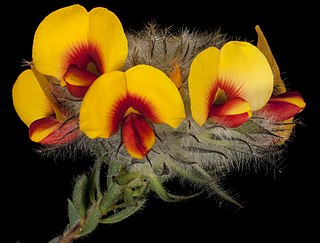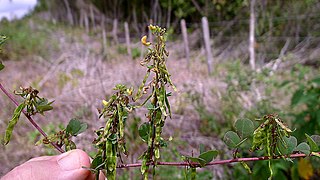
Urodon is a small genus from the family Fabaceae native to southwestern Australia. It includes two species of shrubs which grow in forest, woodland, and heathland.

Phyllota is a genus of flowering plants in the legume family, Fabaceae. It includes 11 species of shrubs native to temperate southeastern and southwestern Australia, in the states of New South Wales, Queensland, South Australia, Victoria, and Western Australia. They inhabit open woodland and forest, mallee woodland, and heathland, from coastal to semi-arid and montane areas.

Dipteryx is a genus containing a number of species of large trees and possibly shrubs. It belongs to the "papilionoid" subfamily – Faboideae – of the family Fabaceae. This genus is native to South and Central America and the Caribbean. Formerly, the related genus Taralea was included in Dipteryx.

Myrocarpus is a genus of flowering plants in the family Fabaceae. It includes five species of trees native to tropical South America, ranging from Venezuela to northern Argentina. Typical habitats include wet to seasonally-dry tropical lowland forest and woodland.
Neoharmsia is a genus of legume in the family Fabaceae. It includes two species of trees or shrubs endemic to Madagascar. Typical habitats are seasonally-dry tropical woodland and succulent thicket or woodland, on limestone or coastal sand, in the northern and western parts of the island.
Ormocarpopsis is a genus of flowering plants in the family Fabaceae. It includes eight species of shrubs or small trees endemic to Madagascar. They inhabit seasonally-dry tropical forest, woodland, and xerophytic shrubland, sometimes on rocky outcrops of sandstone or limestone. They are found throughout the island except in the eastern lowland rain forest. The genus was recently assigned to the informal monophyletic Dalbergia clade of the Dalbergieae. It contains the following species:

Pericopsis is a genus of flowering plants in the legume family, Fabaceae. It includes four species of trees and shrubs, three native to sub-Saharan Africa and one to Sri Lanka, Malesia, New Guinea, and the Caroline Islands. Typical habitats include tropical lowland forest and seasonally-dry woodland and wooded grassland.

Piliostigma is a genus of flowering plants in the legume family, Fabaceae. It includes five species of small deciduous trees native to sub-Saharan Africa, the Indian subcontinent, Indochina, Java, the Philippines, and northern Australia. It belongs to the subfamily Cercidoideae and the tribe Bauhinieae. It is dioecious, with male and female flowers on separate plants.
Candolleodendron brachystachyum is a species of flowering plant in the legume family, Fabaceae. It belongs to the subfamily Faboideae. It is the only member of the genus Candolleodendron. It is a tree native to the Amazon rain forest of northern Brazil (Pará), Suriname, and French Guiana.

Hypocalyptus is a genus of flowering plants in the legume family, Fabaceae. It includes three species of shrubs, subshrubs or small trees native to the Cape region of South Africa. Typical habitats include Mediterranean-climate shrubland (fynbos) at forest margins, in rocky and sandy areas, and along streams, often at high elevations.
Latrobea is a genus of flowering plants in the legume family, Fabaceae. It includes eight species of shrubs endemic to Southwest Australia. Typical habitats include forest, woodland, and heathland on sandy soils and swampy areas in higher-rainfall areas of the far southwest. The genus belongs to the subfamily Faboideae. The plant is named after Charles Joseph La Trobe.
Monopteryx is a genus of flowering plants in the family Fabaceae. It includes three species of trees native to the Amazon rainforest of northern South America, ranging through parts of Colombia, Venezuela, northern Brazil, and French Guiana. They grow in non-inundated lowland tropical rain forest on sandy soil. The genus belongs to subfamily Faboideae. Members of this genus produce hydroxypipecolic acids in their leaves.

Plagiocarpus is a genus of flowering plants in the legume family, Fabaceae. It includes seven species of shrubs or subshrubs native to northern Australia, from the Kimberley region of Western Australia to western Queensland. Their habitats include seasonally-dry tropical to subtropical woodland, bushland and thicket, shrubland, and grassland, typically on sandstone or sandy soils. It belongs to the subfamily Faboideae.

Poiretia is a genus of flowering plants in the legume family, Fabaceae. It includes 12 species of twining, scandent, or erect herbs and shrubs native to the tropical Americas, ranging from southern Mexico to northern Argentina, including Cuba and Hispaniola. Most species are native to eastern Brazil, Paraguay, and northern Argentina; Poiretia punctata ranges further north and west to northern South America, Central America, Mexico, and the Caribbean. Typical habitats include seasonally-dry tropical to subtropical riverine forest, woodland (cerrado), grassland, and shrubland.
Rhynchotropis is a genus of flowering plants in the legume family, Fabaceae. It includes two species of herbs native to the Democratic Republic of the Congo, Angola, and Zambia. Typical habitats include seasonally-dry tropical woodland and wooded grassland in the northern Zambezian region, often in seasonally-damp or open sandy and rocky areas. It belongs to tribe Indigofereae of subfamily Faboideae.
Riedeliella is a genus of flowering plants in the legume family, Fabaceae. It includes three species of scandent shrubs native to Paraguay and eastern and west-central Brazil. They grow in seasonally-dry tropical forest, cerrado, and caatinga. The genus belongs to the subfamily Faboideae, and was recently assigned to the informal monophyletic Pterocarpus clade within the Dalbergieae.
Soemmeringia semperflorens is a species of flowering plants in the legume family, Fabaceae. It is the only member of the genus Soemmeringia.

Vatairea is a genus of flowering plants in the legume family, Fabaceae. It includes eight species of tall trees native to the tropical Americas, ranging from southern Mexico to Bolivia and southern Brazil. Seven species are native to northern South America, with the center of diversity in Amazonia. Vatairea lundellii ranges from southern Mexico to Panama. Most species grow in tropical rain forest, often in the inudated forests known as igapó and varzea, where they are emergent trees, growing above the forest canopy. V. macrocarpa grows in seasonally-dry forest, cerrado, and caatinga.
Vataireopsis is a genus of flowering plants in the legume family, Fabaceae. It includes four species of small to emergent trees, native to northern South America, ranging from Colombia, Venezuela, and the Guianas to Bolivia and southern Brazil. They grow in tropical lowland rain forest, in both the Amazon and Atlantic Forest.

Pterodon is a genus of flowering plants in the legume family, Fabaceae. It includes four species of trees native to Brazil and Bolivia. Typical habitats include seasonally-dry tropical forest, woodland (cerrado), and thorn shrubland (caatinga), often on rocky outcrops. It belongs to the subfamily Faboideae.











